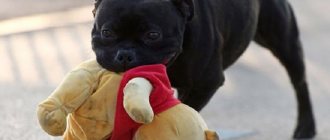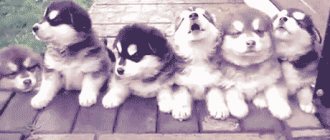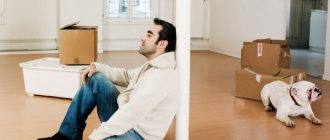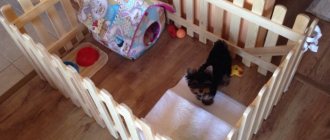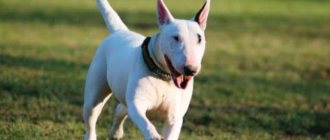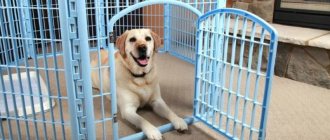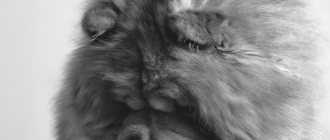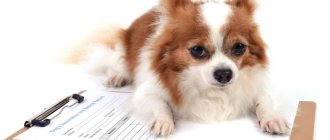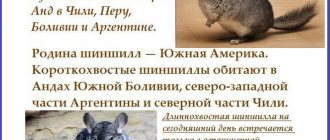What is important for the owner to know
The first thing a person who decides to take a furry friend into their home needs to understand is that a dog is not a toy. A little furry friend is a big responsibility, because a pet will be next to a person for 10, 15, and sometimes 20 years.
It is necessary to thoroughly prepare for the arrival of a new friend in the house. It's not just about a bowl and a bed. Depending on the breed, a person will have to purchase additional things and accessories.
What does a dog need? In fact, the list of necessary things is extensive. In addition, a Chihuahua and a German Shepherd will require different sets of clothes.
Rest
An open rectangular bed made of artificial sheepskin is a soft and cozy sleeping place where you can relax comfortably and at the same time watch everything that is happening around you. There is a comfortable thickened side. The bed is easy to clean and has stylish and non-staining colors. Bed "Voyage maxi", 68x52x5 cm.
She lived with us in her original form for literally two hours. The puppy, while we were distracted, managed to thoroughly dishevel her (which did not prevent him from lying down on the remains of the lounger after that). In fact, the model is comfortable, but for small dogs
. For dogs of medium and especially large breeds, you can buy the most ordinary synthetic blanket, fold it four times, cover it with any blanket or old blanket, and it will be an excellent bed. True, models with sides are the best, so after the first bed we got a second one, larger in size, covered it with a blanket, the dog no longer scratches it.
You can buy a cozy blanket - special for dogs or regular. They can be used to cover a sofa or chair where your puppy will like to sit. Blanket “Funny Puppies”, velsoft, size 90x120 cm. In this size it is very inexpensive, and so cozy... try to part with it and give it to the dog!
What things are needed for a puppy
As you can already understand, the shopping list for a puppy is determined by its breed and age. The younger the dog, the more additional items will be required. So, some babies need to be bottle-fed if they are not already eating normal food.
In any case, regardless of who will live in the house, a Jack Terrier, a pug or a Doberman, the owner will need to equip:
- a special place for sleep and rest;
- feeding area.
A special dog first aid kit is also being collected so that assistance can be provided if necessary.
It is equally important to prepare hygiene products, toys, a leash, collar and muzzle for a walk. Important! Where all sorts of things for dogs will be stored is up to the person himself to decide. Anything that can be chewed, of course, must be within the dog’s reach. But it’s better to put the leash away so that the dog can’t chew it.
Place - pet bed
Everything for walking
The collar should be comfortable and made of durable material. Collars come in metal, nylon, leather and biothane. The latter are considered the best, but can be difficult to find. Experts do not recommend metal collars for permanent use. They are intended more for training; at other times it is recommended to use collars made of softer materials. The length of the collar should be such that the dog cannot remove it over the head, but so that two fingers can be placed between the collar and the neck (so that the collar does not choke the dog).
tag will be useful to make it easy to find your puppy if he gets lost. The tag should include the puppy's name and your contact information, such as a phone number. A chip can handle this task, but a tag will help identify the dog faster.
A harness can be an excellent addition to a collar during walks. Harnesses are especially useful for owners of dogs with thin necks (such as greyhounds). The puppy can always wear a collar, but it is recommended to use a harness only during walks and trips.
The leash can be nylon, rope, metal or leather. Which material to choose depends on your preferences and your puppy's behavior. If the puppy chews on the leash, the nylon and rope ones will quickly break. In this case, it is recommended to purchase a metal leash.
Leashes come in different lengths; there are roulette leashes with a lock. The latter seem convenient to many, but dog experts do not recommend them. This type of leash teaches the dog that if you pull harder, you can get further away. That is, roulette provokes potentially unwanted behavior. An alternative to a roulette leash is an adjustable leather leash.
Bags are needed if you walk your puppy in city parks.
Puppy space and safety
What does a puppy need? The first thing you should worry about is arranging a place for the dog. It is worth choosing a site located in a quiet, secluded area, protected from drafts and warm enough. However, there is no need to place the bed directly next to the battery.
Even if a dog starts in his own home, you can’t immediately throw him out into a kennel on the street. For the first few weeks, the baby should be kept indoors. Especially if he has not yet received the necessary vaccinations. Subsequently, the animal can be moved to an enclosure or a booth with a canopy.
Sun lounger
An important point in the question of what a dog needs is a bed. Of course, just sleeping on the floor or ground will be uncomfortable for the dog, and the small puppy will also freeze. A special bed can be bought at a pet store or ordered online. In this case, it is selected depending on the breed and size of the animal. It is taken for growth so that it is suitable for an adult dog.
The second option is to make a sunbed yourself. This could be an old blanket and pillows. The main thing is that the dog is warm and comfortable. It is worth remembering that some breeds like to bury themselves in fabric; separate capes are placed for them.
Important! You should not move the lounger from place to place. The puppy must know its location exactly. This will make it easier to teach him basic commands.
Fence and playpen
Both owners of large breeds and those who have taken a miniature dog into their home may need a fence or a special playpen. In the first case, they are needed to avoid damage to property. This is especially true for breeds such as huskies, which simply cannot sit still.
If a representative of a small breed lives in a large house, a playpen will also come in handy. This will help avoid a situation where the baby climbs where he shouldn’t. Accordingly, the number of injuries will be significantly reduced.
Treats for pets
Toys
To prevent the puppy from damaging furniture and chewing shoes, it must have entertainment. Games help to waste energy, stimulate brain activity and not get bored when the owner is at work. Different toys serve different functions, so it's great to give your puppy a choice.
Chew toys are especially useful during teething periods. Adult dogs are also not averse to chewing - this is how they train their jaws and clean their teeth. For these purposes, you can give natural treats, for example, SUPERPET deer treats. But the number of treats your pet consumes per day should not exceed 10% of the daily requirement. For example, if your dog's daily intake is 500 kcal, then you should not give more than 50 kcal worth of treats per day. Chew toys are a great addition to treats.
Toys for active games can be taken for a walk or used at home. Such toys include everything that a puppy can run after: balls, rubber toys, rings, flying saucers for dogs, etc.
Distracting toys will keep your puppy occupied for a while and help stimulate his brain. Usually these are toys in which treats are hidden - puzzles, balls with a hole, kongs, etc. These toys are good to leave for your puppy while you are away from home.
The puppy can carry soft toys These toys can help your dog relieve stress, especially if you take the stuffed toy with you on a trip or to the vet. Soft toys absorb the smell of home and the puppy itself. A familiar smell calms you down in a stressful situation.
Treats
What a dog needs in an apartment: the list must include special treats. With their help, you can not only please your dog, but also reward him for good behavior. Special snacks are also used as an element of training.
You can use a variety of options, depending on your pet’s preferences. These can be crackers, cookies, bones, meat sticks and so on. It all depends on the taste preferences of the pet itself.
Important! You need to choose only specialized products. Most things from the human diet are contraindicated for animals. This especially applies to sweet, flour, smoked and salty foods.
We pick up a puppy from the breeder
If you are taking a puppy from a breeder of the breed, then it will be useful for you to find out some details about keeping the pet, and in the future you can always turn to the breeder for advice, because he has experience in raising dogs of this breed.
What you need to know
Ask the breeder about the character traits of your puppy; as a rule, they have time to prove themselves by the age when they are looking for a new home.
Photo: Cole Young It is also important to find out from the previous owner the specifics of the pet’s feeding diet and in the first days of being in the new home you should stick to it.
Information about the puppy’s previous living conditions will be useful; it will make it possible to minimize stress by creating familiar living conditions for him.
It is important to clarify what veterinary procedures were performed on the puppy: deworming, necessary vaccinations, etc.
What to take with your puppy
When picking up a puppy from the breeder, do not forget to take the pet’s veterinary passport, which should indicate the veterinary treatments performed, as well as documents confirming the pedigree (puppy card or birth certificate).
It would not be a bad idea to ask the previous owner of the puppy for some thing or toy that was close to the mother and offspring and absorbed their odors. They will remind the puppy of home and will allow him not to feel lonely; these things will be especially useful on the first night.
How to transport a puppy
Soft carrier It is best to take the puppy home in a soft carrier, but so that his muzzle is outward and he can see everything around him.
If the baby is scared, then hold him close to you, this will calm him down. Keep in mind that on the way he may wet himself or get seasick, so agree with the breeder in advance about the time and ask not to feed the puppy before the trip, and also take water, napkins and bags with you.
A bowl
What else needs to be prepared before the puppy arrives? Of course, the bowl is important. You should choose durable dishes that fit the size of your pet. Ceramics or glass are completely excluded in this case, since they can be easily broken.
In terms of size, you should focus on the following indicators:
- 200 ml for small breeds like Yorkie or Spitz.
- 450 ml for medium breeds such as pug or bulldog.
- 700 ml for large dogs such as Labrador, German Shepherd and so on.
You should also remember that there must be at least two bowls. One is used for food, the other for water. You can use special stands so that the plates do not stand on the floor.
Before the puppy arrives
You need to prepare thoroughly. First, remove from the “reach zone” all objects that can be chewed or dragged in the mouth. A puppy can be interested in absolutely everything that can be reached with its paw or teeth. Little children touch everything with their hands, but a puppy touches everything with his teeth. Wires, tees, books and disks on the floor pose a serious danger.
Chewed objects can be eaten, and then this will lead to surgical intervention! So it is better to prevent your baby from eating them. We also recommend removing decorative rugs and carpets from the floor during toilet training. It is difficult for a puppy to explain the difference between them and a diaper. Removed? Now go downstairs, squat down, and inspect everything again. Can't you eat anything from this angle? Great! This means the puppy’s home is safe! You can invite us to visit!
Tray
The litter box is used for puppies that cannot yet go outside. Some owners leave it for adult dogs of small breeds, such as Yorkshire terriers, if they are already used to it.
Having a tray is not a requirement. For a puppy, you can simply lay a special diaper in a separate pestle. Such an item simply makes life easier for the person himself, especially if you use a good filler.
Doggie tray
Toiletries
Diapers will be useful while you are teaching your puppy to use the toilet outside. While the puppy is learning, embarrassments may occur. In order to minimize them, use special diapers.
The hygiene product will be relevant while the puppy is learning to go to the toilet outside. Sometimes your puppy can't wait to go for a walk, so it's helpful to have a product to help with cleaning. We recommend using products without a strong odor.
First aid kit
When understanding the question of what is needed to bring a puppy into the house, we must not forget about the first aid kit. As already mentioned, this is not the last moment. Some specialized medications prescribed by a doctor will not be there. However, you can place items necessary for first aid, these are:
- disinfectants;
- flea drops;
- antiallergenic substances;
- vitamin complexes;
- drops for ears, eyes and so on.
Attention! Dogs should not be given medications without a veterinarian's prescription; any self-medication is dangerous to their health.
Labrador kennel Tierni
Before you go to pick up a puppy, you must prepare for its appearance in your home. You must choose a place for him to sleep and feed. The puppy will need toys, bowls, a leash with a collar. You also need a first aid kit and much more...
Before putting the puppy on the floor of your apartment, remove the carpets: the child will pee. Teaching a puppy to be clean is not difficult at all. As a rule, he chooses a certain place in the apartment as his toilet. Cover the entire floor with newspapers and wait for your baby to do his business. Praise him, you can reward him with some treat. Gradually, the puppy will learn to go to the toilet only in this place and you will be able to lay newspapers only there. You can also purchase special taming diapers at the pet store.
MANDATORY: even before the puppy arrives in the house, remove various small things that can be swallowed. Do not leave books and other objects on low tables, do not scatter shoes, and be sure to try to cover or remove telephone and electrical wires and extension cords from the puppy. It is worth hiding away all piercing and cutting objects, threads, needles, medicines, chemicals, etc.
Place for a puppy
top of page
First of all, you need to determine where the puppy will rest, chew his favorite bone and toy, that is, find a “place” for him.
The puppy should have its own place from the first day of its stay in your home. In principle, a Labrador can simply sleep on a hard floor, but since Labradors have a lot of weight and, accordingly, have a tendency to form calluses on the elbows, it is advisable to create a soft place while the dog is still small.
It is best to purchase a ready-made sunbed. It is necessary to take into account that when getting comfortable, the dog stomps around for a while, spins around, and can also rake the bedding under itself, and if the bedding is filled with batting, down and similar fillers, then very soon it will begin to tear and release its contents. Holofiber is good as a filler; it is 100% polyester, silicone impregnated. Improves thermal insulation and hygienic properties. Resistant to washing and dry cleaning. Does not absorb foreign odors, does not cause allergies, and is resistant to moisture. Prevents dust mites, fleas and other insects.
Labradors are big fans of sleeping with their head on a pillow, so it wouldn’t be a bad idea to buy a pillow for the crib as well. 
A small puppy can be placed on a regular mattress with an easily removable and washable cover. A good option is with a thick polyester “skin”. You can buy a regular mattress, or order a piece of foam rubber according to the size of the dog, and sew a cover (preferably two) yourself. For an adult dog, you can make a special trestle bed (size 60x90 cm) on legs about 20 cm high (this way you will protect your pet from drafts, and it will be more convenient for you to clean).
It is worth looking into some large pet store, where you will find a lot of beautiful mattresses, cribs, etc. (and of very good quality). We recommend paying attention to Ferplast products.
Convenient folding bedding. You can take this one on a visit or on a hike. The outer fabric is dense and abrasion resistant. The inner side is artificial fur, easy to wash, soft and comfortable for the dog.
A bed cover is very convenient if you allow your dog to lie on sofas and chairs. Beautiful, has many color variations, easy to wash.
Comfortable, soft bed for dogs. You can order a personalized option. Thanks to the soft sides, you don't have to buy a pillow.
Elegant, warm mattress for dogs. There may be options both densely stuffed and thin (for summer).
Folding bed. Can be additionally equipped with a mattress.
A very stylish crib with a soft mattress. But it’s still better not to take wicker beds and baskets: puppies, as a rule, quickly destroy a beautiful place. In addition, they are difficult to wash.
New development from Ferplast. We have not yet tested it, but, like all products produced by the company, it inspires confidence. The crib can be made either soft, springy, or hard (using a retractable leg). The mattress is fixed to the crib with special latches. The legs are stable and the bed does not slip.
Great sofa! Soft, comfortable and has somewhere to rest your head. Most dogs prefer it.
Place the lounger away from radiators and drafts and not on the passage itself, so that the baby feels calm. Often, the dog itself finds the most comfortable place for itself. You can move the crib there.
Of course, if you want, you can give the puppy a personal chair, but he definitely needs a place to hide his toys there, or to hide himself, or, in the end, so that you can send the dog to his place when the doctor or guests come.
But the dog should not remain in place all the time. Labrador cannot stand being alone. Even a small puppy will want to be near you almost all the time, do not deprive him of this.
Remember that the puppy is growing, and immediately take a 1.5-2 meter lounger. The store will tell you which bed is best for your Labrador.
Never punish a dog in its place if it managed to escape there, do not drag it out of there, this is its home, and you are invading it, undermining the dog’s trust in you. This is personal territory. Here no one has the right to do anything with her: neither play, nor punish. If you have children, warn them that the puppy is not a toy and should not be squeezed or pulled by the ears or tail. Strictly ensure that children do not violate the privacy of the puppy in its place. Otherwise, you risk getting a nervous, unbalanced dog.
Don’t be upset if the puppy doesn’t appreciate the crib carefully purchased for him; sometimes, only after several months, or even a year, the Labrador begins to love a cozy place. True, it often happens that a puppy refuses the place offered to him for some reason (inconvenience of the bedding, a specific smell, the wrong place, etc.) Try to understand what’s wrong and correct the situation.
The puppy's area must always be kept clean and tidy, shaken out and vacuumed regularly.
Feeding area
top of page
The puppy should also have a designated place to feed. It must be permanent. It is best to buy two bowls - one for food, the other for water, made of stainless steel with a rubber rim on the bottom so that the puppy does not chase this bowl all over the kitchen. Bowls are purchased in “adult” sizes.
Plastic bowls are less durable. They very quickly crack, break or are chewed by the puppy himself. But you still need to buy one such bowl - it is lightweight and convenient for use at exhibitions or on the road.
Folding bowls made of special fabric are convenient when transporting a dog. True, if you are not on the road all day, but in a specific place, a standard plastic bowl is still desirable.
Heated bowl. Good if the dog needs special care. But there is a danger that the dog will chew the cable!
Automatic feeder and drinker. Convenient in case of departure. It is worth remembering that in summer the water in such drinking bowls deteriorates very quickly.
Combination bowls. They do not slide on the floor and do not rattle when the dog eats.
It is believed that the puppy should slightly reach for food, then his posture will form correctly, and it is simply easier to clean up after him if the dog eats from elevated bowls. Previously, there was an opinion that if a puppy eats from a stand, the height of which was determined by the height of the dog’s elbow (the bowls are reinstalled as the puppy grows), then he would have an ideal back, neck, etc. (by the way, it’s no longer possible to push an empty bowl around the apartment).
Is it worth building a stand for bowls? It's up to you. Today you will not hear clear advice on this matter. But still, the dog’s exterior is laid down at the genetic level, and what is supposed to grow, it will grow, although, of course, environmental conditions also play a huge role. Think for yourself and watch a puppy or an adult dog: the time to absorb food is a matter of seconds. So when will she have time to ruin her back? And then take a closer look - what does she (especially the male) do on the street? The whole walk, with his nose in the ground, he sniffs out something. And, believe me, not a single dog’s posture has deteriorated because of this!
But keep in mind that a bowl on a stand will be simply irreplaceable if the dog experiences back pain. If your lab is more willing to eat from a bowl on a stand, then you should not deprive him of this.
Feed
top of page
At first, you should feed the puppy the same food that the breeder fed. Even if you are a supporter of this or that type of feeding, or are sure that the food of such and such a company is better suited for your pet, you should not experiment on your baby, it can end in intestinal disorders at best. Wait at least a month to change the food, and then gradually switch it to the one you think is necessary.
Nowadays there is a huge range of food in stores. The main thing is to choose the right feeding for your Labrador, taking into account the individual characteristics of his body.
So, there are three types of feeding:
- Natural feed
- Dry food
- Mixed feeding
If you choose the first option, then do not expect that it will cost you less than dry feeding.
With a properly selected diet (it should be prepared by a professional specifically for your dog), you will spend a lot more money and time purchasing all the necessary components.
If you feed natural food, then in addition to cottage cheese and kefir, you should also give natural products: meat (frozen lean beef), vegetables, cereals (only buckwheat and rice), sea fish, black bread crackers.
When feeding natural foods, you will need to add vitamins and special supplements to your food.
To be honest, for a long time I was a supporter of exclusively natural nutrition, but after some events I changed my mind. But do not forget that dry food must also be specially selected for your dog.
Below is a list of the most popular and high-quality feeds (at the end of the article there are tables on the composition of these feeds):
- Hill's
- Ekanuba
- Nutro Chois
- Royal Canin
- Happy Dog
Although food manufacturers do not recommend combining dry food with anything else, many experienced breeders do not support a completely “dry” diet and, in addition to dry food, give kefir with cottage cheese (low-fat), meat, fish (sea) and definitely something to chew on.
When training a dog, it is better to reward it with a piece of apple, cheese, or black cracker.
To cleanse plaque, it is useful to give unchewable bones with cartilage and pieces of meat.
Never give your dog sweets!
Care items
top of page
Several equipment for grooming (caring for a dog):
- Furminator is the most effective comb! Must have!
- Comb , preferably double: with rare and frequent teeth.
- Massage brush with plastic ends.
- Terry towel . An old terry sheet or an old towel 30x30 cm will do. A dry dog can be wiped with a damp towel, first against and then along the fur. Thus, the wool is moisturized and acquires shine, dust and dandruff are removed.
- Shampoo for dogs. It is best to buy an expensive one, but of high quality. For example, professional Bio-Groom. The series includes a special shampoo for puppies “Fluffy Puppy”. The tar-sulfur “Bio-Med” from the same company is also good. Shampoos and “8 in 1” are also very good.
- Claw cutter. Their nails are trimmed. In this case, you should always have a means to stop the bleeding on hand (in case you cut the claw too short). It is better to buy a German claw clipper, made of good durable steel (otherwise there is a possibility that it will fall apart right in your hands). There is an alternative - to trim the nails at a veterinary clinic, but this takes time and money.
- Overalls. During slush and mud, it is best to walk with your lab in overalls. He won’t need a warm winter coat with fur, but a raincoat that will save you from washing your dog several times a day is simply necessary. To do this, go to any pet store that sells overalls and try it on! It is worth measuring on the dog. Pass the labric several times, see if its movements are constrained.
Accessories
top of page
Although you can start walking only after vaccination at three months, you need to accustom your baby to a collar as soon as he gets into your home. And also gradually to the influence of the leash. Then you will avoid unnecessary stress during your first walks, and the puppy will run obediently on a leash.
For a walk, you will need to buy a collar and several leashes: 1.5 meters for regular walks; 3-5 meters (about three centimeters wide) for special cases (for example, during a heat, the bitch must be kept only on a leash, and a leash of this length will be needed). A longer one is inconvenient, it drags along the ground and the puppy can get confused, a short one is also inconvenient - the puppy cannot move normally.
Leashes should have a strong, comfortable carabiner and fit comfortably in the hand. It is necessary to ensure that the dog does not chew the leash. As a precaution, it is important to have a spare made of polyester webbing.
The collar should be light and durable, the size of the neck, preferably with reflective marks (you can attach reflective soft reflectors to the collar yourself), preferably made of soft leather, with a sign or tag (plastic snap-on - the rest unscrew and get lost), on which the telephone number is written owner.
Check the quality in advance - the ring on the collar must be reliable, welded, and the collar itself must be lined with a soft lining. Check all the seams - they should be double, there should be no threads sticking out anywhere.
Very beautiful and reliable leashes from Rogz and Ferplast. Rich color range plus various designs.
Bright and elegant nylon collar with chain. Stitched with reflective thread.
The collars are also beautiful, but unfortunately, the plastic clasp is not reliable and durable enough.
Leather collar.
Never replace a collar with a harness! Since the harness creates an incorrect positioning of the dog’s forelimbs, and as a result, their close position and elbows turned outward. As a result, the dog will have abnormal movements.
If the dog is a show dog, it also needs a show ring. A show leash is a thin cord with a ring attached at one end and a hand loop at the other, which is put on the dog like a noose. A show leash is usually matched to the color of your retriever - black, brown, white or yellow. This leash does not have a restraining function - it is intended only to demonstrate a perfectly obedient dog in the ring.
Just in case, you should buy a muzzle and train your dog to use it. Most often it is used during walks to prevent the dog from picking up all sorts of things on the street.
By design, muzzles come in mesh, blind and loop types.
Mesh muzzles are the most comfortable and common type. They are usually made of leather or metal wire, but there are also muzzles made of plastic, mainly for small dogs. They look like a basket that is attached with straps behind the dog's ears. Leather is preferable in the cold season. But in the summer, a dog can feel hot wearing a leather muzzle. A metal muzzle is comfortable at any time of the year, except in very cold winter.
A blind muzzle consists of an almost solid piece of leather that fits fairly tightly around the dog's muzzle. Only a small cutout is left for the nose and tongue. Such muzzles are the lot of vicious dogs with powerful jaws. The main disadvantage of such a muzzle is that if it is chosen poorly, the dog runs the risk of heatstroke.
Loop muzzles are similar to those used in circuses for bears. One type of loop muzzle is the veterinary examination muzzle. They are made from nylon and fit tightly around the dog's jaws. These muzzles are not suitable for long-term use and walking.
The protruding tongue of a dog is a kind of heat conductor organ. And this must be taken into account when choosing a muzzle. A dog wearing a muzzle must be able to open its mouth and breathe freely. The muzzle should not cut into her nose, eyes, or cause pain or discomfort. A nylon muzzle is preferred. It is light and practically not felt by the dog. The muzzle must be fitted to the dog at the pet store.
Toys
top of page
Stock up on toys for your puppy. If he has something to chew on, you won’t have any problems with damaged shoes (street shoes are a source of various germs, and this is dangerous for a small puppy), torn wallpaper, curtains and tablecloths, or destroyed books. When your puppy grows up, don’t take his toys away. Retrievers will play with them all their lives and enjoy every new toy gift. It is absolutely necessary to buy several cast rings, a rope with a knot, and a large cast ball (which cannot be swallowed) in advance. Buy your puppy all kinds of balls of different sizes, rubber rings, bones made of sinew or rubber. Squeaky toys will also attract his attention (but they must be durable enough).
Why are die-cast toys better? Hollow toys can fold up, and the playful puppy will not notice how he accidentally swallows a ball that has suddenly become flat. Latex “squeakers” are interesting to the puppy, but they are painfully short-lived. At the first holes, they must be thrown away, again because of the danger that the puppy will swallow the torn parts. Do not let your puppy chew on soft toys - he may eat the cotton wool and padding polyester with which they are stuffed.
You should definitely let him chew the bones from the veins. Only without dyes. The puppy can chew gum for quite a long time, and this is some guarantee of the safety of the apartment in your absence.
Make sure that there are no metal parts in the toys - dogs can swallow them.
Toys should not be given all at once, then the puppy will be interested in suddenly “finding” the forgotten ring when he is already tired of playing with the ball.
Do not allow your retriever to tug on sticks with other dogs or pull on cloths or the leash. All this can ruin your bite. Don't let your puppy chew on sticks outside. A leash, sticks, the owner's old shoes, rags should never be your pet's toys. After all, for him there is no difference between your old sneaker and new shoes.
If you catch a dog chewing something it’s not supposed to, reprimand it like this: “Ugh! Look for a toy! Then praise her when she engages with the toy. If you suddenly return home, and everything there is chewed up and turned upside down, then go to a quiet, secluded corner and scold yourself there: “Bad owner! Stupid owner!
How can you be so unreasonable as to allow an untrained puppy or a dog with a dominant chewing need to run around the house? Give your dog complete freedom in the house only when you teach him to chew only what he is supposed to. By the way, if you successfully completed this task, then an additional reward awaits you: busy chewing his favorite toy, your dog will not continuously bark and whine from boredom alone, driving the neighbors into a frenzy.
If the puppy stubbornly tries to chew furniture, walls, carpets, in a word, spoil property, then you can purchase a special anti-gnaw spray at pet stores ("Chew Halt"). Spray it several times in the places that the puppy has chosen, and if this does not help, then you can buy a cage where you will lock the puppy while you are away.
It is best to put a container - a ready-made kennel for your Labrador, which you can take with you on an air trip, and the puppy can be closed at home during cleaning, so that it does not get in the way, or while you are away, so that it does not cause any trouble. For a retriever, you can purchase a “vari-kennel” container in an “extra-large” or “large” size. At the bottom you need to lay a mattress or rug made of a material that can be easily washed or cleaned with a vacuum cleaner. The puppy’s “place” must always be kept clean and tidy.
First aid kit
top of page
It includes:
- lotion and ear cleaning sticks
- cotton swabs (for treating wounds)
- adhesive plaster - two spools 1.5 cm wide and two spools 2.5 cm wide (for paw cuts)
- bandages (simple and elastic) 4 and 7 cm wide (for paw cuts)
- at least ten bottles of hydrogen peroxide solution and a couple of packages of hydroperite (in tablets)
- two packages of chlorhexidine (Miramistin) solution as a local antiseptic
- synthomycin emulsion 5 and 10% (for bites and cuts)
- children's medicine for diarrhea
- anthelmintic drug for 17 and 40 kg of live weight (usually six tablets)
- medical tourniquet to stop bleeding
- instructions in pictures (how to stop bleeding from cut paws)
- oilcloth
- enema No. 1 and No. 3
- pipette
- tweezers
- syringes for 2, 5 and 10 ml
- chamomile (dry)
- Vaseline oil
- ointment "Boro+", or "Rescuer", or "Levomikol"
- potassium permanganate
- Activated carbon
- tavegil or suprastin
It is important to write down and always have on hand the phone number of your veterinarian, the phone number and address of your nearest, as well as 24-hour veterinary clinic.
You will also need a rag and a lot of newspapers, patience and time, which a little retriever will require from you, but believe me, you will have a lot of fun watching your puppy grow. And they grow very quickly!
Care and hygiene products
Any breed, be it a Corgi or an Alabai, needs to be bathed sooner or later. This should only be done with a special shampoo. It is very important to select separate cosmetics for animals with allergies.
Grooming products
Certain breeds, such as poodles, require regular grooming. It is best to have the procedure done by a professional. Especially if the animal attends exhibitions. However, if a person grooms himself at home, then he needs to acquire:
- comb;
- scissors or clipper.
Pet food
This is one of the most important, or rather even the main points. First of all, you must decide what you will feed your dog: dry or natural food.
If you prefer natural food for your pet, then carefully study all the important points of this method of feeding. What foods can and should be given to a four-legged animal, and which are strictly contraindicated. Learn how to properly feed a puppy, because the whole rhythm of life and the rules of feeding babies are quite different from the established lifestyle of an adult dog.
If you choose to feed dry food, then consult with experienced dog breeders which food is best. After all, dry food differs very much in its composition and beneficial qualities.
Be sure to ask the breeder what the baby ate. If you eat dry food, then ask or buy some of this food from him. Subsequently, you yourself will be able to switch your baby to any other food or natural food. But this needs to be done gradually so that the puppy does not have health problems. Read about how to properly switch your dog to natural food.
If the breeder fed the baby natural food, then be sure to find out all the cooking details and whether the puppy is allergic to any foods.
Collar and leash
A collar, leash, and muzzle are needed for all dogs that go outside, and not only that. Flying abroad or across Russia by plane, traveling by public transport or train is simply impossible without these things.
Important! The only vehicle where you can remove all or part of the devices is the owner’s car. And then, it is recommended to maintain safety.
Sizes are selected individually, depending on the size and age of the dog. It is best to go to the pet store with your animal and choose the appropriate option.
Necessary accessories: collar, leash, muzzle
Transport accessories
Often there is a need to transport a puppy in your own car or on public transport, including to a veterinary clinic. For such moments, it is necessary to purchase specialized tools. These include, in particular, the container - it must match the size of the puppy and not be too tight. For large animals, a harness or seat belt is useful, reliably securing the animal in its place in the car.
Hurry up, choose a box and find out what gift awaits you
Discount on pet insurance
Promo code copied to clipboard
Vet Tips: Pet Accessories
What veterinarians primarily advise is to monitor the quality of things that are purchased for the dog. At best, bad items and accessories will simply quickly become unusable. However, often low-quality toys, collars or leashes led to the pet’s physical condition suffering.
The article talks about everything that dog owners may need. Most items can be purchased in advance; the main thing is to know which breed will soon appear in your house or apartment.
Useful video
We found a video for you from a professional dog lover who knows exactly what a puppy might need:
Of course, each puppy is individual and any conscientious owner wants to give him everything he needs. And the pet will definitely respond for this care with his love and devotion, because it’s not for nothing that they say that there is no better psychotherapist than a puppy licking your face.
How do your pets show their love? Perhaps they are trying to lick you while jumping, or are they starting to spin around like clockwork? Leave comments, because everyone who keeps a dog at home has an interesting story or a funny photo with their pet.
Upbringing
Often, a puppy finds itself in a new family at about 2 months. In terms of development level, such a baby can be compared to a one-year-old child. Don't expect too much from your puppy, but you should start training now.
Education and training are two different concepts. In simple terms, the first refers to everyday behavior, and the second to commands. Without good manners, it is unlikely that you will be able to teach your dog to perform tricks, and there will be little point in doing so.
Only one person should handle the puppy both at home and outside. At this time, the baby can be taught simple commands: “come to me”, “sit” and “lie down”. Don't overload your puppy, he's just a child! Over time, he will master the rest on the court.
Basic rules of education:
- No favors. If you don't want your adult dog to sleep on the bed, don't let him do it as a child. The ban should not be influenced by either circumstances or your mood. The rules are general and they apply to all family members.
- After a pet has been punished, everyone should ignore it for a while. Animals love to seek protection from others, look pitifully into their eyes, sigh and demand attention in every possible way. Resist, otherwise the punishment will be ineffective.
- Get used to the collar and leash early. For a puppy, such accessories and the first walk are stressful. Your pet will feel doubly anxious if you introduce so many changes at once.
- While the baby cannot go outside, teach him to do things in the tray or in the diaper. He must maintain cleanliness.
- A trusting relationship with a puppy is the key to future success. Make a connection, communicate, spend time with the animal, pay more attention. How can you tell if your pet is friends with you? If he greets you joyfully, jumps up, barks or squeals joyfully, follows you around and gets bored when you're not around, you're friends.
When can you walk your puppy?
After repeated revaccination, which is done at about 3 months, you need to undergo quarantine. It lasts 2 weeks if there are no complications. At this time, the baby’s body is actively fighting against weakened bacteria, so stress and external microbes are of no use to him. After quarantine, you can take your puppy for a walk for the first time.
First of all, let your baby get used to the collar, and only then fasten the leash. Make the animal feel comfortable and confident. Talk to him kindly and encourage him. Lure with treats and praise your pet for coming near you.
The puppy may be scared or experience intense joy and curiosity. In this case, the baby will break free and pull. Don't let him do this. Make it clear that you will not remove the leash anyway, this is a kind of rule.
Don't be afraid to tighten the collar. A smart dog will turn towards you and easily slip out if he is too loose.
Your pet should associate the walk with positive emotions. Play with him, feed him something tasty. For greater efficiency, you can even feed the dog outside at first, instead of at home, rewarding him for completed commands.
Don't pull your dog while walking! He must walk on a slightly loose leash, otherwise he will get used to breaking. Don't risk your pet's life: don't let him go where cars drive. If you let your animal run, unhook the leash. The dog can quickly become entangled in it, get caught on something, break its paws or suffocate. If there is another animal nearby, then the pet, actively playing, injures it too.
